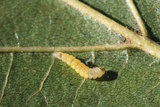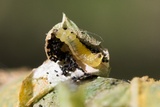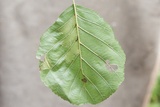Phyllonorycter klemannella (Fabricius, 1781) Species
Last modified: Dec. 10, 2025, 5:17 p.m.
A widespread and common species in Belgium, mainly observed in Flanders.
Details
- Classification
- Family: Gracillariidae > Subfamily: Lithocolletinae > Genus: Phyllonorycter > Species: Phyllonorycter klemannella
- Vernacular names
- Goudrugelzenvouwmot (NL), Dark alder midget (EN), Goldrücken-Erlenminiermotte (DE)
- Synonyms
- Phyllonorycter kleemannella auct.
- First mention in Belgium
- De Fré Ch. 1858. Catalogue des Microlépidoptères de la Belgique. — Annales de la Société entomologique belge 2: 45–162. On page 157. view page
- Status
-
Native
Distribution
Imago
Head ochreous to brown; forewing ground color golden brown, a white pattern consisting of two transverse bands, two costal and one dorsal striae; a small dark spot in the apical area; basal line absent.
Museum specimens
No pictures yet!Specimens in nature
No pictures yet!Mine
A tentiform mine on the underside of a leaf, situated between two secondary veins and most of the time not close to the main vein. Underside without clear longitudinal fold, but with several small wrinkles. The black frass is concentrated in a corner of the mine.
See also gracillariidae.net and bladmineerders.be.
Cocoon/pupa
A tough, white cocoon, attached to the roof of the mine, without any frass.
Bionomics
The eggs are oviposited singly on the underside of a leaf, but many eggs can occur on one leaf.
The species hibernates in the pupal stage in the cocoon among fallen leaves between leaf litter on the ground.
After the emergence of the adult the pupal skin protrudes from the mine.
Adults rest during the day on tree trunks, they become active at dusk and come to light.
Flight periods
Two generations a year in April–May and August.
Observed on
- Host plant (species):
- Alnus glutinosa and Alnus incana
The larva lives mainly on Alnus glutinosa, but it also occurs not infrequently on Alnus incana.
Habitat
River sides, open places in forests.



